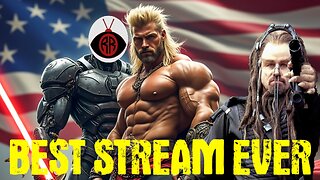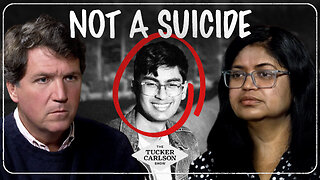Premium Only Content

Leo Frank Trial - Hugh Dorsey Closing Arguments Part 6
When they went to the enemy's camp to get ammunition, Rogers and the Black honest men noticed his anxiety. Frank, the defendant in this case, explains his anxiety as a result of the car ride and seeing the body as he attempted to explain his condition by inhaling gas. The light, which had always burned brightly, had been turned back so that it was now burning like a lightning bug, Old Newt Lee claims to the jury.
He discovered this when he returned to the cellar. Then Leo M. Frank dims the light in the hopes that Newt Lee won't find the body that night. Harry Scott is sent to find the Pinkerton agent on Monday night, and there is no need for an affidavit to force him to tell the truth. The most crucial information in this text is that when Scott, the witness, first saw Frank at the factory on Tuesday morning, he was tense and pale. Frank was pacing his office inside through the windows, according to Wagner, who was sent up there to watch him from across the street, and he looked out at him twelve times in the thirty minutes before the officers arrived to take him. On the way down to the station, Scott became agitated and uneasy as he observed Frank pacing his office inside and gazing out at him twelve times in the thirty minutes before the officers arrived to take him.
When Scott saw Frank pacing his office inside and gazing out at him twelve times in 30 minutes through the windows on the way down to the station, he became agitated and uneasy. It is clear why Hammond was anxious after hearing Dunbar's testimony in the case against him for the murder of two young children.
The heaviness of guilt, fear, regret, and terror was the cause of it. The ghost of the dead girl, the cord, the blood appeared, and the ghost of this trial, the prison of the gallows, and the grave of infamy guilt, forces itself into speech and behavior. Mr. Rosser contends that even if our religion is a fraud and a farce, it still teaches that man can be saved, enjoy a good character, and have the respect of those around him.
The unrefuted testimony of people who have known John Dalton since he left his hometown of DeKalb and Fulton, as well as the testimony of C.T Maynard, a witness who cannot be easily discredited, are the most crucial details in this text. The three weeks that Newt Lee spent there were spent by Newt Lee, who witnessed with his own eyes this man, Dalton, enter a pencil factory with a woman in support of Conley.
When this man, Conley, was taken into the custody of the Atlanta police department, Mr. Rosser said he would give anything to find out who had dressed him up. In response to the ruling made by His Honor, Judge Roan, Mr. William Smith, a person hired to defend this Black Conley, set up. The most significant information in this text is that Jim Conley is currently being detained at the police prison of the city of Atlanta after initially being detained in the Fulton County prison. He is a crucial witness in the prosecution's case against Leo M. Frank on behalf of the State, so it is important to have him present at the trial to prevent the prosecution's case from being dismissed. Respondent demonstrates to the court that the city police prison is set up and staffed in such a way that he is completely safe from any attack that might be made against him. He also demonstrates that his cell is solitary and that the key to his cell block is always in the possession of a sworn uniformed officer of the law. The request to remand him back into the custody of the honorable men who would oversee the Atlanta police force was granted by Judge Roan. The most significant information in this text is that Mr. Dorsey was released from custody and that the order transferring him to Fulton County's common jail was revoked.
Mr. Rosser contests that the judge's order remanding him to the Atlanta police's custody was the right course of action. The court then nullified both the orders committing him to prison and the order transferring him, making it appear as though no orders had ever been made. Judge L. Roan then issued an order transferring Mr. Dorsey to the City of Atlanta Police Department.
The most crucial information in this passage is that Jim Conley was not whisked away from Georgia when he entered the courtroom to take the oath, and that he had been released from all forms of custody. He was discovered to have had access to the National Pencil Company's cash register, but nobody other than the National Pencil Company's hirelings impeached him for his general bad character.
Even in broad daylight and during working hours, it was demonstrated that he had relationships with Miss Rebecca Carson, the woman on the fourth floor. His own witness, Miss Jackson, claimed that he arrived when the girls were relaxing and unwinding after finishing their piecework. With the exception of the National Pencil Company's hirelings, these facts demonstrate Jim Conley's repudiatory Negro status and general bad character. Jim Conley, Miss Kitchens, Amos Jackson, Darley and Maddie Smith, McCrary, Monte Stower, Daisy Hopkins, Lemme Quinn, Dalton's statement that he had previously seen Jim watching on weekends and holidays, and Daisy Hopkins' statement that he had seen her enter the factory with Dalton and go down that scuttle hole to the location where that cot is displayed. Frank's statement that he would consult with his attorneys regarding Quinn's statement that he had visited him.
All of these assertions are supported by the evidence offered by the four women in charge, including that of Jim Conley, Miss Kitchens, Amos Jackson, Darley and Maddie Smith, McCrary, Monte Stower, Lemme Quinn, Daisy Hopkins, and Frank's room.
Frank also stated that he would consult with his attorneys regarding Quinn's assertion that he visited him in his office, and Dalton stated that he had previously seen Jim watching on weekends and holidays. Daisy Hopkins also stated that he had. In addition, he discussed the retracted affidavit given to the police in Minola McKnight's presence and how plenty of cord was used to strangle the young girl to death. These details are crucial because they demonstrate that the murder was committed by a man who stayed at home and hurried back to the factory, and the use of the cord found in large quantities to choke the girl to death.
The two most crucial facts in this passage are that Jim Conley wrote a note to conceal a crime and that no Black person has ever before in the history of the race done the same. The note paper on which it was written was widely scattered on the office floor and close to Frank's office, and Jim Conley claimed to be the author.
Mr. Rosser and Mr. Dorsey each read a list of page numbers that contained the statement that Mr. Arnold was referred to in. Mr. Arnold was mentioned in a list of page numbers that Mr. Rosser read aloud.
The most crucial information in this text is that Mr. Dot Arnold reported the official report written by the official stenographer and that Mr. Dorsey quoted Frank as saying, "I did it and I done it. "The jury heard that testimony as well as Jim Conley's cross-examination, and each time he was questioned, he responded, "I done it Mr. Rosser," and the stenographer recorded it accurately. Mr. Perry is confident that he can make a declaration that will please Mr. Dorsey after reporting one to 31 on his own.
There is no reason for a reporter to confuse Did and Done because they have very different shorthand characters. Mr. Dot Perry and Mr. Dot Dorsey contend that a black person will occasionally adopt the language of the white person for whom he works. The context of the notes indicates that Mary was attacked as she went to get water, and Mary only knows of one closet—the one on the office floor where Conley claims to have discovered the body.
This demonstrates a deliberate effort on the part of someone to limit and exclude the crime to one man, and this fact supports Conley. Frank also backs up Conley's claims regarding the time of his arrival at the factory on Saturday morning, the duration of the visit to Montagues, and the existence of the folder that Conley claims to have in his possession. According to Perry's claim, Harry White received $2. The two most significant facts in this text are that Frank kept a voucher book and allowed each and every person to sign for the money they received, and that Arthur White borrowed $2 from Frank ahead of time on his wages. This voucher book was used for Express, kerosene, and any other imaginable expenditure of funds.
Frank was unable to provide the signature of White or any entry in his books proving that this man White ever received the money, with the exception of the entry made by Schiff a week or so later. This is due to Frank's inability to produce White's signature or any entry he made in a book proving that White ever received the money, with the exception of Schiff's entry from a week later. The most crucial information in this passage is that Frank did not ask for or accept White's receipt as payment for that amount because his thoughts and conscience were focused on the crime he had committed.
Frank's claim that he had family in Brooklyn and the evidence in the case both support this. With regard to a man by the name of Mincy, Old Jim Conley was subjected to a great deal of questioning. Echo responds that Mincy was a myth or a cunning perjurer, and that this man knew that bringing him before a jury would make them queasy. Jim Conley is supported by the absence of Mincy because if Mincy had been able to refute Jim Conley or had been able to persuade Old Jim to admit that he was involved in the crime in any way, he would have been found if someone had gone through the entire state of Georgia with a fine-tooth comb, from Rabun Gap to Ty B Light.
The most important details in this text are that the defendant, Leo M. Frank, is guilty of the murder of Mary Phagan, a little factory girl who died because she wouldn't yield her virtue to the demands of her superintendent. The defendant's actions, words, and circumstances in the case all prove him guilty of the crime, and the jury has taken the oath to try the issue formed on the bill of indictment between the State of Georgia and Leo M. Frank, charged with the murder of Mary Phagan. The jury has taken the oath to try the issue formed on the bill of indictment between the State of Georgia and Leo M. Frank, charged with the murder of Mary Phagan. The jury has taken the oath to try the issue formed on the bill of indictment between the State of Georgia and Leo M. Frank, charged with the murder of Mary Phagan. The jury has taken the oath to try the issue formed on the bill of indictment between the State of Georgia and Leo M. Frank, charged with the murder of Mary Phagan.
-
 1:00:27
1:00:27
Trumpet Daily
20 hours ago $3.91 earnedCongress Humiliates Itself - Trumpet Daily | Jan. 15, 2025
12.7K15 -
 1:49:46
1:49:46
Glenn Greenwald
1 day agoTrump Fosters A Peace Deal With Israel & Gaza; Trump's Pressure On Israel Embarrasses His Enemies & Provides Foreign Policy Clues; Rubio & Hegseth On War And Militarism | SYSTEM UPDATE #389
128K183 -
 1:28:46
1:28:46
Donald Trump Jr.
19 hours agoOut of this World: Breaking News Investigation on Secret Alien Aircrafts, Live with Ross Coulthart & Lue Elizondo | TRIGGERED Ep.207
333K479 -
 1:39:31
1:39:31
Space Ice
15 hours agoSpace Ice & Redeye: Battlefield Earth & Rob Schneider
86.8K7 -
 1:33:38
1:33:38
Flyover Conservatives
1 day agoAMANDA GRACE | Prophetic Warnings Ignored: What Happens When Leaders Defy God | FOC Show
72.3K40 -
 59:57
59:57
The StoneZONE with Roger Stone
14 hours agoMEDICAL MURDER: A Sneak Peak into the Making of Died Suddenly 2 | The StoneZONE w/ Roger Stone
58.7K13 -
 1:07:03
1:07:03
Tucker Carlson
13 hours agoMother of Likely Murdered OpenAI Whistleblower Reveals All, Calls for Investigation of Sam Altman
161K195 -
 55:44
55:44
LFA TV
20 hours agoCongress Humiliates Itself | TRUMPET DAILY 1.15.25 7pm
155K58 -
 1:42:04
1:42:04
2 MIKES LIVE
15 hours ago2 MIKES LIVE #167 News Breakdown Wednesday!
98.4K16 -
 2:12:19
2:12:19
Quite Frankly
18 hours ago"Fahrenheit 2025: Drone Hysteria, The Fog, Smart L.A." ft. Elana Freeland 1/15/25
104K27